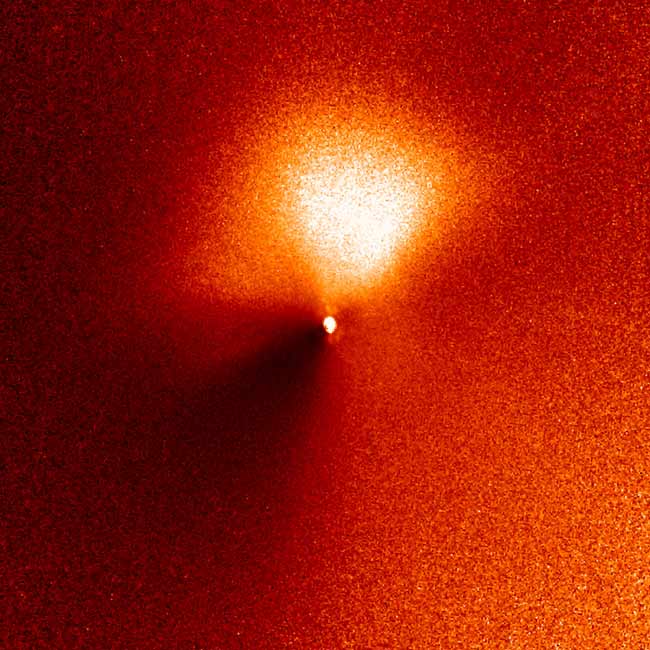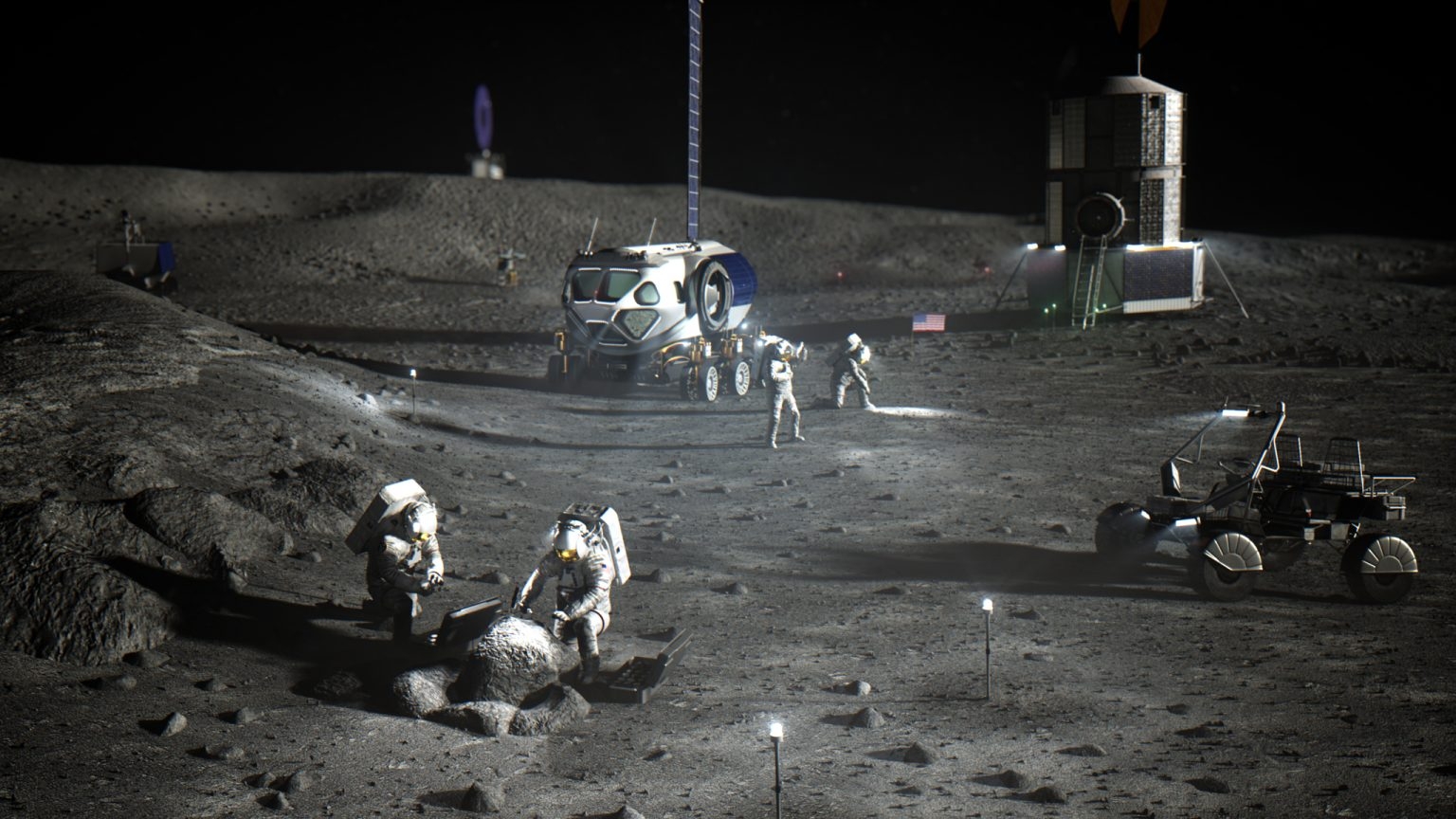NASA's Deep Impact Spacecraft on Target for Comet Crash

PASADENA -- With a littlemore than two days left in its six-month journey, managers for NASA's DeepImpact mission said the spacecraft is on course to make its historic encounterwith a comet late Sunday evening.
The mission is slated tocrash an 820-pound (371-kilogram) Impactor probe into Comet Tempel 1 and recordthe event via a Flyby mothership. The impact is expected to take place at 1:52a.m. EDT (0552 GMT) on July 4.
"I'm pleased to report thatboth the Flyby and the Impactor spacecraft are ready for encounter operations,"Dave Spencer, Deep Impact's mission manager at NASA's Jet Propulsion Laboratory(JPL), announced today at a mission briefing.
The announcement followsseveral major mission milestones that were achieved over the past two weeks.
On June 23, the spacecraft successfullycompleted its third trajectory correction. The burn of the spacecraft's engineschanged Deep Impact's speed by 13 miles per hour (about 21 kilometers per hour).Another trajectory correction for final targeting before Impactor release isscheduled for 8:00 p.m. EDT July 2 (5:00 p.m. PDT).
Mission planners separatedthe spacecraft's flight operations into six mission phases; launch,commissioning, cruise, approach, encounter and playback. The five-day encounterphase incorporates the final approach to the comet and transmission to Earth ofcollected data.
Fresh comet science
Breaking space news, the latest updates on rocket launches, skywatching events and more!
Although Deep Impact isstill about 1.7 million miles (2.7 million kilometers) from Tempel 1, it isalready giving astronomers an eyeful. Onboard cameras have picked up several outburstsof material jetting out of the comet, most recently on June 30, and allowedresearchers a chance front row seat to the phenomenon.
"We've known for a long timethat comets have outbursts, but we don't know what drives them," said MichaelA'Hearn, Deep Impact's principal investigator at the University of Maryland,during the briefing. "We are getting great science now."
One such outburst was sostrong it nearly doubled the amount of water in hazy cloud, called a coma,surrounding Tempel 1's nucleus, mission scientists said. In addition to water,Deep Impact's onboard spectrometer has also picked up traces of complexhydrocarbons, carbon dioxide and carbon monoxide, they added.
Deep Impact researchers saidthat past probes to comet Halley in 1986, comet Borrellyin 2001 and comet Wild-2in 2004 recorded images at resolutions that ranged between 328 feet (100meters) - or just over an entire football field - and about 75 feet (about 23meters).
"Our spacecraft is going toresolve items about the size of the football," said Don Yeomans,co-investigator for Deep Impact at JPL. "So that's good."
But it's the main eventastronomers are waiting for. Mission scientists hope Deep Impact's Impactorprobe will punch through Tempel 1's outer surface and reveal inner materialthat has lain unchanged since the formation of our solar system.
"Literally, these materialshave not seen the light of day in 4.6 billion years," said Jessica Sunshine, amission co-investigator at Science ApplicationsInternational Corp. (SAIC).
Impactor separation
On late Saturday evening, 24hours prior to its estimated collision with Tempel 1, the Impactor willseparate from the Flyby mothership and begin its final approach on the comet. The mothership will then adjust its course to monitor the Impactor's mission,Spencer explained.
"Twelve minutes later the flybyspacecraft--now flying on its own--will turn and perform its largest maneuver ofthe entire mission," Spencer said. "It will slow itself down by about 220 milesper hour relative to the Impactor ... this slowdown will allow it to witness theimpact events itself and subsequent crater formation for about 13 minutes afterimpact."
Should something go wrong and the Flyby craft fail to break away from Tempel 1 after Impactor's release, there is a contingency plan to ram both vehicles into the comet's surface, Spencer added.
During the entire encounter, both theImpactor and Flyby will use medium and high resolution imagers and an infraredspectrometer to collect and send to Earth pictures and spectra of the event.
The plan is not withouttechnological and environmental risks: Following impact and the initialobservations, the Flyby spacecraft will adjust its position, using its shieldedsolar array to protect its major hardware from any debris thrown up from thecomet's surface by the collision. During this time the mission team will beworking at full speed to download as much information as possible from thespacecraft, systems engineer Jennifer Rocca said.
"We will try our best totransmit the highest priority images from both Flyby and Impactor before Flybyreaches its closest approach to the comet," Rocca explained. "This allows us tocapture our very best data even if Flyby suffers damage as it flies close toTempel 1."
The spacecraft will beassisted with information gathered by a variety of spaceborne science platformsincluding the Hubble and Spitzer space telescopes, the Chandra X-rayObservatory, the Swift and Submillimeter Wave Astronomy satellites, theEuropean Space Agency's XMM-Newton X-ray observatory and the Rosettaspacecraft. Observatories on Earth will view the impact and its aftermath.
All information transmittedfrom Deep Impact will be collected on Earth for mission managers through NASA'sDeep Space Network (DSN). The DSN consists of three deep-space communicationsfacilities placed approximately 120 degrees apart around the globe: one atGoldstone, in California's Mojave Desert; a station outside Madrid, Spain; andthe last near Canberra, Australia.
"Our antenna coverage forour short encounter event is absolutely critical," said Rocca. "So we plannedour impact to occur in an area of overlap between a 70-meter antenna atGoldstone and a similar one in Australia."
SPACE.com Staff Writer Tariq Malik contributed to this story from New York City.
- Deep Impact: Viewer's Guide and Mission News
"ADC" is a digital media executive and freelance journalist with ADC Strategy who previously contributed to Space.com in the arenas of human spaceflight, comets, and space exploration. As the Editorial Director of Consumer Media Imaginova Corp. he was responsible for editorial oversight of Space.com, LiveScience.com and the custom publishing of AdAstra magazine for the National Space Society. He's played a pivotal role in expanding the Consumer Media portfolio and developing custom editorial packages for major corporate sponsors. Under his watch, Space.com was awarded the 2003 Online Journalism Award for Breaking News by the Online News Association for its coverage of NASA's Columbia space shuttle disaster. His writings have most recently appeared in the Silicon Valley Business Journal.
